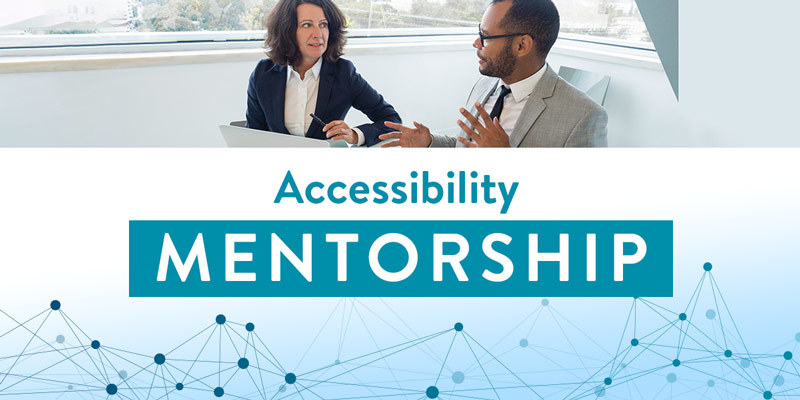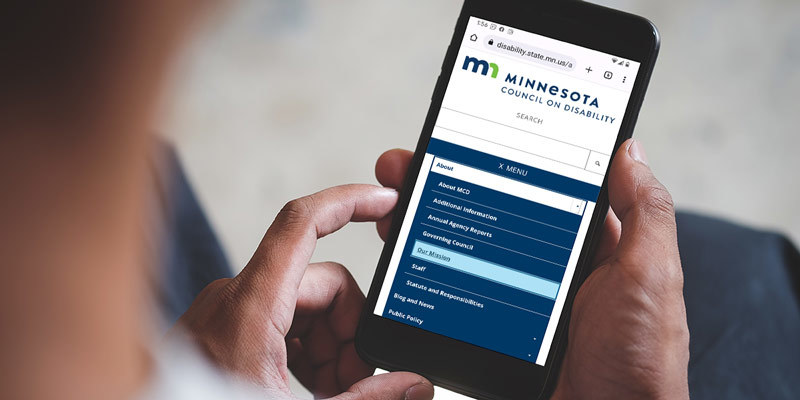 Accessibility Mentorship May Be Just What You Need!
Information for Mentors, Mentees, and Mentorship Programs
By Sam Alley, Fusion Learning Partners and Jennie Delisi, Office of Accessibility
We know the right things to do. Things like:
- Eat your vegetables.
- Get some exercise.
- Make your digital content accessible for everyone.
Turning these thoughts into action, and eventually habits, can be hard.
Mentorship is one way to move a good idea into a daily practice.
There is a lot of technical learning that comes along with digital accessibility. It’s the whole routine of plan, do, test. But what about:
- Having tough conversations? Example: Advocating for accessibility with a group when it may impact their current project timelines and budget.
- When you can’t find information on a specific topic?
- When you need advice on your next set of learning goals?
Sam Alley from Fusion Learning Partners, the nonprofit organization that produces the annual Government IT Symposium, wanted to improve their digital content's accessibility. For six months he partnered with Jennie Delisi from the state of Minnesota's Office of Accessibility. They dedicated a small amount of time each month to studying and took notes along the way to share with you.
This article provides information for mentors, mentees, and those running mentorship programs. Whether you want to learn more about digital accessibility, or have accessibility skills to share, check out the tips in: Accessibility Mentorship May Be Just What You Need!
 WCAG 2.1 – Improving Digital Accessibility
Improving Navigation Menus and Focus Indicators
Editor’s note: We are beginning a series of articles called WCAG 2.1 – Improving Digital Accessibility. This month, we hear from a digital accessibility coordinator about work done in Minnesota to improve the accessibility of state websites. These are works in progress. Subscribe to be sure you get each installment in this series!
Minnesota Council on Disability
Chad Miller, CPACC, Digital Access Coordinator for the Minnesota Council on Disability, shares information about ongoing work on their website. They have been working on two specific areas of their website – the navigation menu and the focus indicator.
Chad shares information about:
- What they had before.
- Why it needed to change to meet WCAG 2.1.
- The steps they followed to make the change.
- How he tested to validate it now met 2.1.
Getting ready to update your site to 2.1? Learn along with us! Read Chad Miller's installment in WCAG 2.1 - Improving Digital Accessibility.
 Tech tip: Don’t Skip the Skip to Content
Just like the film "Groundhog Day," doing the same thing over and over is tedious. It also wastes one of our most precious resources: time. Some things repeat on every page on a set of webpages. For those with vision, you don't even notice them after a while unless you need to use them. For people relying on assistive technology, unless the page provides an option to skip them, they must interact with every single one of them.
The Office of Accessibility received 2 questions about links used to bypass repeated blocks of content, sometimes known as skip to content links:
- Where is the skip to content supposed to take the user?
- How can I see where it's gone?
Consider the top of most webpages. They often include:
- A linked logo.
- A search option.
- Links to multiple pages on that site.
Screen reader users rely on having content read aloud to them. Keyboard-only users (or similar assistive technology users) interact with each interactive element. Their goal, if they have been to this page before: get to the main content. And what happens when they go to the next page on the site? They must do it all over again, just like in Groundhog Day.
The skip to content is a same page link. It is at the beginning of a web page. Its job is to give a person using assistive technology the ability to skip all those things that happen on every page.
Answer to question 1:
- The skip to content takes you to the content that is not repetitive.
A “skip to content” is a link. Sometimes it is visually present on a page when it loads. Other times if you use your tab key, it will become visually "exposed." If focus is on the skip to content link, using the enter key brings you to its target - the location after the repetitive content.
You can inspect the code to find the target. You can also use a tool like WAVE to show you where it is. If it is working as expected, WAVE includes both the skip link and its target under Features in the Details tab. If they are not working, you will find them under Errors. Selecting the skip link target icon will bring you to the specific content.
Answer to question 2:
- Review the code manually or use a testing tool to identify the skip link target. Then, decide if this is the correct location.
Ready to learn more about bypassing repeated blocks of content and skip links? Check out the W3C's Understanding SC 2.4.1: Bypass Blocks (Level A).
|